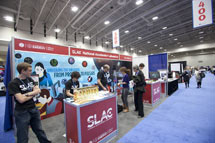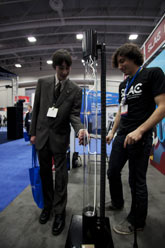
Handy Links
SLAC News Center
SLAC Today
- Subscribe
- Archives: Feb 2006-May 20, 2011
- Archives: May 23, 2011 and later
- Submit Feedback or Story Ideas
- About SLAC Today
SLAC News
Lab News
- Interactions
- Lightsources.org
- ILC NewsLine
- Int'l Science Grid This Week
- Fermilab Today
- Berkeley Lab News
- @brookhaven TODAY
- DOE Pulse
- CERN Courier
- DESY inForm
- US / LHC
SLAC Links
- Emergency
- Safety
- Policy Repository
- Site Entry Form

- Site Maps
- M & O Review
- Computing Status & Calendar
- SLAC Colloquium
- SLACspeak
- SLACspace
- SLAC Logo
- Café Menu
- Flea Market
- Web E-mail
- Marguerite Shuttle
- Discount Commuter Passes
-
Award Reporting Form
- SPIRES
- SciDoc
- Activity Groups
- Library
Stanford
Around the Bay
SLAC Joins DOE Row at AAAS
Washington, D.C.—Over the weekend, SLAC National Accelerator Laboratory joined nine other Department of Energy Office of Science laboratories in the Walter E. Washington Convention Center exhibit hall in Washington D.C. for the 177th annual meeting of the American Association for the Advancement of Science. The laboratories set up exhibit booths with giveaways, hands-on demonstrations and scientists answering questions. This is the first time that all of the Office of Science laboratories have set up exhibits at the AAAS meeting under the common banner of "DOE Row."
"We're very proud of the Office of Science, the fact that it supports nearly 25,000 people directly and another 25,000 roughly who come to the scientific user facilities at all of our labs, " said Patricia M. Dehmer, deputy director for Science Programs at the Office of Science. "All ten of [the Office of Science laboratories] are here at this meeting. And so we're very happy that the scientific community is able to come and walk through the exhibition and see everybody."
The annual AAAS meeting features a series of lectures and talks on current topics in a wide range of science subjects. This year's meeting lasted from February 17 to 21. According to the AAAS website, more than 8000 conference attendees, including "scientists, engineers, policymakers, educators and journalists from some 50 nations met…to explore a broad range of recent discoveries and looming global challenges." AAAS also opens the exhibit hall, free of charge, to the general public during its "Family Science Days," the activities for which it says are geared mostly toward middle- and high-school students.
SLAC's booth caught the attention of passers-by with a five-foot tall glass cylinder containing what looked like a glowing ribbon of light. The cylinder actually held pressurized krypton gas, and a 9,000 volt difference between its top and bottom. The voltage difference ionizes the krypton, or separates into charged particles, and creates a glowing stream of light. SLACers at the booth then held magnets up to the glass to demonstrate how a magnet can deflect the path of the charged particles, and move the ribbon of light. This illustrates a concept at the heart of SLAC's linear accelerator and the Linac Coherent Light Source, which steer a beam of electrons using magnets to generate X-ray laser light.
Visitors could also put on 3-D glasses and watch, on a high definition monitor, a stunning simulation of two galaxies colliding in space. This simulation and many others like it were created by members of the Kavli Institute for Particle Astrophysics and Cosmology at SLAC, which also shows these simulations to the public in the KIPAC Visualization Lab. Comments from some of the younger viewers included, "Woah," and "Awesome."
And before leaving, booth visitors received their own "X-ray photons," specially designed plush toys wearing cartoonish X-ray glasses. The toys became a much-desired commodity at the meeting, and appeared dangling from many attendee conference badges.
"People are actually swarming around the booths, listening to the scientific explanations, doing the hands on demonstrations," Dehmer said. "It's really rewarding to see this."
—Calla Cofield
SLAC Today, February 22, 2011

